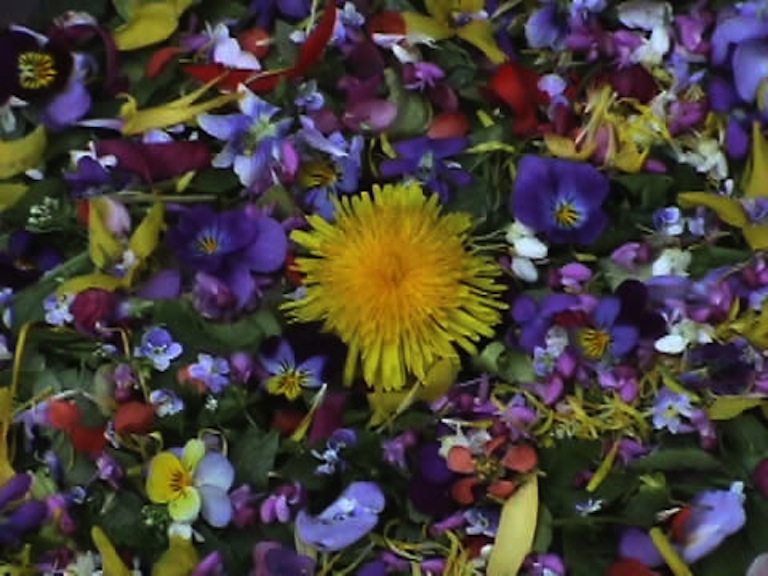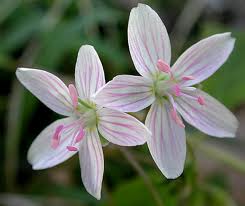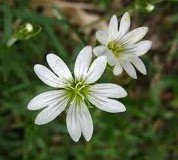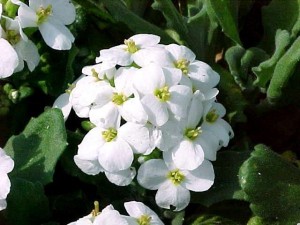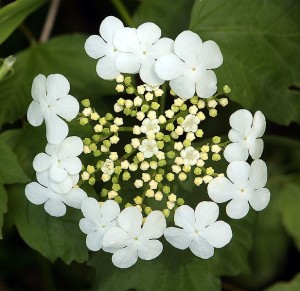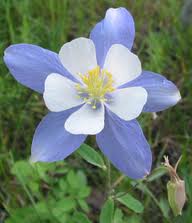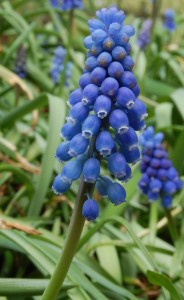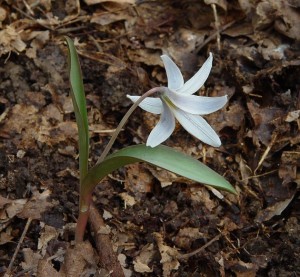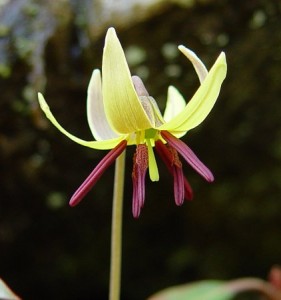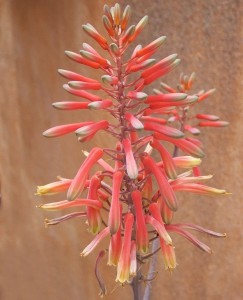Spring Beauty, Chickweed, Alpine Cress, High Bush Cranberry, Columbine, Hyssop, Musk Hyacinth, White Trout Lily, Yellow Adder’s Tongue, Aloe
The Spring Beauty, also Springbeauty, Claytonia virginica, is a longtime standard for foragers. They are abundant in some areas, rare in others. Thus forage with some local consideration. True to its name the attractive wild flower is a sign of spring and easy to recognize from other spring blossoms. The white to pink petals have pink stripes, sometimes pale, sometimes bright, but pink stripes nonetheless. Each blossom also only has two sepals (leaves right under the blossom.) Lower leaves are strap-like varying in size and width. The plant grows small roots that remind people of tiny potatoes, hence the nickname “Fairy Spuds.” The flowers as well as the parts above ground are edible raw or cooked. There are several edible Spring Beauties. To see a separate article on site click here.
Chickweed, Stellaria, is not a blossom that comes to mind when one thinks of edible blossoms because one rarely separates the small blossoms from the rest of the chickweed before it becomes food. However, the deeply-lobed
tiny five-petaled blossoms can be separated and sprinkled like white snow upon salads. Admittedly this is more for effect but isn’t that part of why we eat pretty flowers anyway? Also note the Native Americans did not let the weed’s small size deter them. They also used the minute seeds to make bread or to thicken soups. And of course, the rest of the chick weed above ground can be used as a potherb. It can be eaten raw if you like the flavor of raw corn. Some folks just toss everything into a blender and make a green drink out of it. To read more about chickweed, click here.
As the name suggests, you have to go up to find Alpine Cress. It’s no flatland flower, and also as the name suggests, it is in the greater mustard muster. Alpine Cress, Arabis alpina, grows in the mountainous areas of Europe, north Africa, eastern Asia, and the Isle of Skye (Cuillin Ridge to be exact.) It is also found in North America including Kentucky, Virginia, West Virgina, Wisconsin, Michigan, New York, Maine, most of Canada, and Greenland, hardy little soul that it is. It likes to grow in damp gravel and screes. Not surprisingly it can be found in many places intentionally planted in rock gardens. The young leaves and flowers are a good substitute for cress. They are edible raw or cooked and are often mixed with other greens as a flavoring.
High Bush Cranberries are not cranberries but that’s all right because we are interested in the flower, though the fruit is edible, too. Actually Viburnum trilobum, not a Vaccinium, the High Bush Cranberry favors cooler climates, think the north half of North America, Europe and Asia. The blossoms of the High Bush Cranberry is rather odd in that it has sterile large flowers around the outside of the blossom and fertile tiny flowers in the middle. While both types of flowers can be used the larger outside ones are more practical and leave the fertile flowers to make berries. The flowers can be mixed with pancake or muffin batter or can be made into fritters.
Sometimes within a genus there will be toxic species and edible species. The Aquilegia are that way. Most of them are toxic with alkaloids, four are not, one in east Asia, three in western North America. Thus making sure you have the exact species is quite important. Close is not good enough. Edible in North America is Aquilegia caerulea, the Rocky Mountain Columbine. The nectar-heavy flowers are eaten as a snack or tossed into salads. They also make a good jelly. The Hanaksiala Indians got nectar from the blossoms of the A. formosa (Western Columbine) while the Miwoks boiled and ate the early spring greens of the A. formosa var. formosa (Crimson Columbine.) In eastern Asia the species is A. buergeriana, also called Yama-odamaki. Its sweet flowers are sucked for their nectar and also used in salads. The leaves are also edible. One other columbine might have edible uses. A. canadensis root was reportedly eaten by Native Americans.
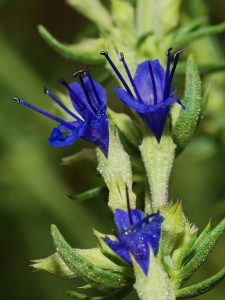
Hyssopus officinalis
The Hyssop, Hyssopus officinalis, is quite well-known. The leaves and tops of young shoots are used to season soups, salads, pickles, sauces, custards meats, stews and dried for tea. Its bitter-mint oil is used to flavor beer, liquors, and bitters. It is one of the main flavors in Chartreuse. Native to the Mediterranean, it is cultivated globally. What is not often reported is that the blossoms are edible as well, usually added to salads or made into syrup. There are several cultivars. The word Hyssop comes almost directly from the Greek word υσσοπος (EEs-so-pos.) It’s naturalized in the northeast quadrant of North America and North Carolina, Colorado, Montana and Saskatchewan.
Often plants that are wild in Europe are cultivated in North America, making them difficult to classify. The Musk Hyacinth is such a plant. Botanically Muscari neglectum, the Musk Hyacinth has urn-shaped blue blossoms. They are used as flavoring in Europe. The bulbs are also boiled then eaten. Blossoms of the Indian Grape Hyacinth (Muscari botryoides) are also picked. It is naturalized in North America in a patchwork of areas including the eastern U.S. and Canada, the Pacific coast of the U.S. and Canada plus Texas, Utah and Nebraska. The high plains states and the desert southwest are left out as is South Carolina, Georgia, Florida and Louisiana. A close relative, Leopoldia comosa, the Tassel Hyacinth, is used extensive particularly in Italian and Greek cooking. The bulbs are boiled then pickled or preserved in oil. They are thought to stimulate the appetite and are also diuretic. Interestingly wild ones are preferred over cultivated ones. It is found in the upper south and mid-west of the U.S. as well as Oregon and Washington state.
Our next two blossoms are in the same genus, Erythronium. The White Trout Lily is E. albidum and the Yellow Adder’s Tongue is E. americanum. First the White Trout Lily: Flower stalks, flowers, buds and the white bell-shaped flowers can be eaten raw or cooked. The young leaves are edible raw as well. They are crisp, tender, and tasty. However, the plant only has two leaves so if you are going to harvest them harvest only one leaf per plant. The bulbs are also edible after boiling. They are considered delicious. However, in large amount they can be emetic so consume within reason.
The Yellow Adder’s Tongue is slightly different. Like its relative its flower stalk, flower buds, and flowers are edible raw or cooked. The leaves can be eaten raw, such as in salads. Again, the plant only has two leaves so harvest responsibly. E. americanum bulbs can be eaten raw or cooked. They are crisp and chewy. However again, consume sparingly as they can be emetic. A third Erythronium, the European E. dens-canis, the Dog’s Tooth Violet, also has edible cooked roots. It is also the source of starch use to make pasta-like noodles or cakes. Leaves are eaten boiled. Don’t let the common name of the E. dens-canis — Dog’s Tooth Violet — confuse you regarding violets. Violets are in the genus Violas. Violas do not have edible roots.
The last flower to wrap up this “dekalogos” is the Aloe, but not necessarily the Aloe found in the health food store. Several Aloes have flowers with nectar that can be consumed, much like the nectar of the Tulip Tree blossom which starts part 19. Among the sippable blossoms are A. ferox and A. marlothii. A. zebrina has edible flowers and buds after being boiled. In Angola they are pressed into cakes. A. greatheadii flower buds are a delicacy after being boiled in three changes of water. There is no report on the edibility of Aloe vera flowers. But since that plant is medicinal, I would not eat them.

